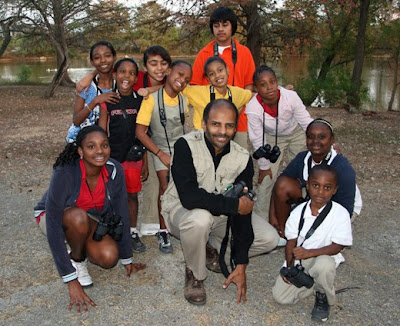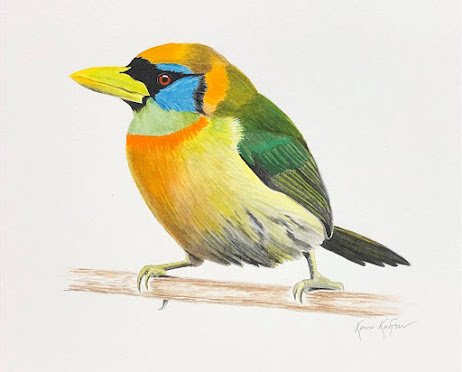Living Colors: Diversity and the Future of Birding
From Oak Harbor, Ohio, Kenn writes: Okay, here’s some talk about a subject that a lot of us seem to have trouble talking about.
My serious interest in birds began at age six, but at first I birded alone. Then as a young man I was traveling and meeting other birders just a few at a time. So after two decades I still didn’t have a real sense of what the birding community was like. Finally by about the time I hit thirty, I was getting invited to speak to bird clubs and birding festivals all over the continent, and it dawned on me: Wow, we’re practically all white people here.
Once I had noticed, it was strikingly obvious. I’d be doing a bird program for an audience of 200 in New York, or South Carolina, or Alabama, or Chicago, and I’d realize that there wasn’t a single black face in the crowd. Or I’d be talking to a large group at a bird meeting in California or Arizona or Texas, and there would be hardly a face in the room that looked Hispanic or Native American.
The situation remains unchanged today. Kimberly and I live in Ohio, where the population is (according to the 2000 census) about 12 percent black. But when I go to popular birding spots, like the boardwalk at Magee Marsh in spring, the ratio of black birders that I see is not 12 percent, which would be one out of eight people - - it’s more like one out of three hundred. Likewise at big birding festivals and popular birding sites elsewhere on the continent, people of color are just vanishingly scarce.
Why does this bother me? Two reasons.
One, I hate the idea that there might be something exclusionary about birding. I would never join an organization that practiced any kind of discrimination. The birders I know are not racists; I’d like to think we’d be overjoyed to welcome more people of color into our fun times in the field.
But secondly, I’m concerned about bird conservation and the future. Birds and their habitats need all the friends they can get. If an interest in birds continues to be mainly something for white people, support for bird conservation is going to decline. The group that the Census Bureau categorizes as "Non-Hispanic Whites" already makes up less than 50 percent of the population in California, Texas, and New Mexico, and if current trends continue, the same will be true for the U.S. as a whole in a couple of decades. If we really care about the long-term survival of our bird populations, therefore, we need to bring a more diverse crowd of people into the birding world.
Fortunately, there are a few people who are not only talking about this issue, but actively doing something about it. And some of those leaders in the field are coming to our area of Ohio in about a month, bringing practical info on what we can do about it. I’m proud to say that our Black Swamp Bird Observatory is partnering with Toledo Metroparks and Ottawa National Wildlife Refuge to put on a conference: Diversity in Outdoor Recreation: The Many Faces of Conservation. You can read all about it right here. Kimberly and I will blog some more about this issue within the next couple of weeks, but in the meantime, if you can make it to Toledo on September 26, come and join us! This is a great chance to show your support for diversity and learn what to do about it.
 Here’s our friend John C. Robinson, taking a group of enthusiastic and fun-loving young birders out on a field trip in California. John is a leading authority on the issue of diversity in the outdoors, and the author of Birding for Everyone: Encouraging People of Color to Become Birdwatchers. He will be a featured speaker at the conference on September 26.
Here’s our friend John C. Robinson, taking a group of enthusiastic and fun-loving young birders out on a field trip in California. John is a leading authority on the issue of diversity in the outdoors, and the author of Birding for Everyone: Encouraging People of Color to Become Birdwatchers. He will be a featured speaker at the conference on September 26.


It's a really thought-provoking issue. I'm involved in a Young Naturalist's Club in Raleigh, NC, and we have a couple members who are black, which is great because, like you, we really want to reach out to those who share our community, especially if they generally don't have the opportunity to get into nature study normally.
ReplyDeleteThe problem is that these kids live in homes where their parents (and often parent) aren't able to get to field trips or meetings because they often work weekends and evenings, or have other children to take care, or any other issues that they have to deal with. So often we go out of our way to pick them up which works but adds so many other complications coordinating and communicating and there's only so many of us in charge to do it. I can certainly see how, in the interest of just making things easier, these kids who would otherwise have a real interest just fall through the cracks. And that's too bad.
I'd be really interested to hear what comes out of the conference, because it seems to me that there are a lot of kids who would really be interested in nature study if they just had the opportunity. And that definitely good for the community of birders.
Kenn - Yup, definitely an important topic that does not seem to come up very often. I'm half Korean and because of this I think I'm a bit more attentive to the demographics of birders than most....in 15 years of birding I can count on one hand the number of black birders Ive met. It's not right!
ReplyDeleteFor me, too, this has long been an issue of unease, and for precisely the reasons you cited, Kenn. Here in New York City, the ratios are no better.
ReplyDeleteI would like to point out, though, that the 25th World Series of Birding included an African-American team for the first time in its history. The proverbial exception to the colloquial rule, perhaps, but a welcome one nonetheless.
Growing up in the inner city myself, there just isn't any importance placed on nature.
ReplyDeleteWhen you look around in the city, trees and nature aren't very plentiful and schools don't have the time or budgets to discuss it.
I think that is the root of the problem.
I have thought about this before. This past spring there was a school bus load of black children that descended upon Magee Marsh while we were birding. Most of them didn't have binos. The Dads that were along were making fun of the kids that did have bins and were trying to see 'something'. A few were attended by a lady that was trying to show a few with bins a bird or two. I thought it a great thing.
ReplyDeleteI wouldn't know how to go about engaging someone of color to bird. I live in a small town where I don't even see people of color except when they come to attend the small University here. My world is small I guess.
I like to think (hope) that something as much fun as birding will catch on through out the community. I can't even get my friends interested in birding. I know I have tried to get my Grandchildren interested. There again they live far from me. Sigh~~
I read John Robinson's book and noticed the lack of diversity before I ever heard anyone talk about it. I plan to invite some new people birding that don't fall into the all white category. I'm glad that you are making an issue of this.
ReplyDeleteThanks for these thoughts. I still remember how the idea that we should care about this issue was hotly disputed in Birding magazine back in the 90s.
ReplyDeleteI loved working with minority elementary school students at Hornsby Bend near Austin, and just heard about one of those girls who we taught in our outdoor education field trips as a fourth grader and is now doing an environmental internship as a high school student. I'm sure the teenage girls that went owling with us last time I taught an owling workshop at Hornsby will remember seeing that Barred Owl with a mouse for the rest of their life. Maybe they'll even get interested in more serious birding sometime.
Share the joy!
Very thought provoking...and it's not
ReplyDeletejust in the States either. I believe that to make birding a more desireable, compelling activity with youth (of any colour) it needs to become a part of the school science curriculum, and regarded as "important" by those teaching it. Programs such as birding libraries for borrowing binoculars can be developed, but first the spark has to be ignited.
Having grown up in an extremely diverse area (northern Virginia, just outside of D.C.)I've often noted and wondered about the lack of diversity across the board in the birding world. I've noted of late a few Hispanic names and faces, but the dearth of black birders is particularly striking.
ReplyDeleteI wondered, yes, but I never looked more deeply into it or tried to do anything about it.
Thank you for focusing on this disparity!
DG
It might be true that there is little emphasis placed on nature in inner cites, but not all members of minorities live in inner cities. This is a stereotype we can do without. Many blacks, Hispanics, and Native Americans are suburban or (especially) rural. The problem may lie in part in socioeconomic status: leisure time, discretionary income, etc. But only in part - I wouldn't want to perpetuate a stereotype there, either.
ReplyDeleteDG
I appreciate you bringing up this topic! I have always wondered myself where the breakdown is with birding/ nature and diversity in the U.S. I don't think it is lack of interest. For the past two years, we have sponsored "Celebrate Urban Birds" a program from Cornell with approx. 800 students and some of these students were within the Indianapolis area. I am always amazed at the enthusiam that all children show with nature but especially urban children! So many simple things that we take for grantite in the natural world is new to them - I wonder what the solution is?
ReplyDeleteGreat blog you got here. I'd like to read more concerning this theme. Thanx for giving that data.
ReplyDeleteJoan Stepsen
Tech and gadgets